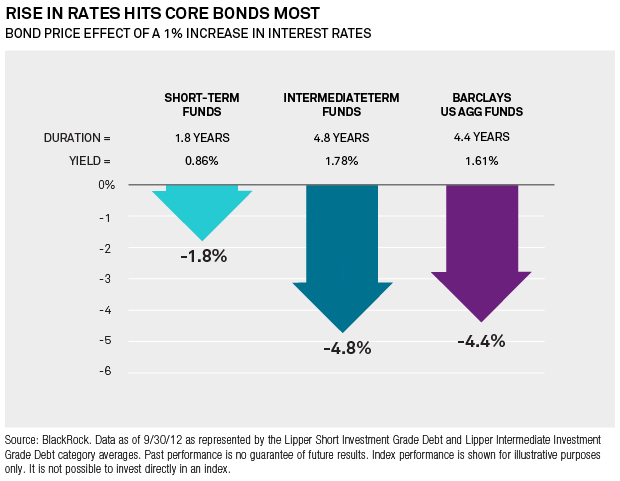How to Protect Your Portfolio from Rising Interest Rates
Post on: 28 Май, 2015 No Comment

Image by Getty Images via @daylife
Many of you are aware of nervous U.S. investors and how their flight to safety during the past two years has driven them increasingly toward bonds and away from stocks. This is true regardless of the long-run track record of stocks and the trend toward lower yields for bonds caused by the increasing demand for bonds by both the government and investors.
As market yields fall, the value of outstanding bonds will increase. Why? Take the following example. A $1,000 face value bond with 30 years to maturity which pays the investor $40 per year (usually paid as $20 every six months) will be worth $1,000 if market yields are 4%. If market yields fall to 2.5%, however, that same bond would be worth $1,314. This has been the picture we’ve seen over the past few years and is essentially what has occurred in markets from April 2010 (when the Treasury rates were close to 4%) to today, when Treasury rates are 2.45%, the lowest they have been since December of 2008.
We need to ask ourselves, what would happen if interest rates increase? We can answer that by taking the above example and turning it around. The 4% coupon rate bond that is worth $1,314 today will be worth $1,000 if rates return to 4%, resulting in a 24% loss in value. So, what should an investor do to protect their portfolio from rising rates of interest? Here are a few options:
www.treasurydirect.gov/indiv/products/prod_tips_glance.htm .
Dividend paying stocks – Near the end of August, AT&T had a preferred stock that paid a dividend yield of 5.94%, a bond maturing in 2029 that paid 5.49%, and AT&T’s common stock had a dividend yield of 6.24%! Moreover, there is a promise to pay the interest on the bonds before paying the preferred stock dividend, and a promise to pay the fixed preferred stock dividend before paying anything to the common stock holder – yet a move toward dividend paying stocks might have benefits. (AT&T has the greatest dividend yield in the Dow Jones Industrial Average and may point to the risk that investors might be factoring into AT&T’s future, but it is instructive. Yesterday, the dividend yield on AT&T was 5.80%, but the price of the stock has risen from $26.94 to $28.94 over the past few weeks.)
www.indexarb.com/dividendYieldSorteddj.html )
Convertible Bonds – Convertible bonds are bonds that pay a fixed semi-annual rate of interest, lower than the rate paid on bonds that are non-convertible. In exchange for the lower rate, they grant the holder of the bond the right to convert the bond into the common stock of the company. The result is that convertible bonds tend to move in a positive direction to changes in the economy, while providing income, though less than non-convertible debt, until the owner is forced to convert the debt into common stock. (I say “forced” because the holder of convertible debt should not voluntarily convert. To do so, removes the “floor price” of the convertible debt when valued as debt, while the value of the convertible as stock will always be worth the conversion value, if the stock price continues to increase. If you need the money from an appreciated convertible bond, just sell the bond.) There are mutual funds that specialize in convertible bonds.
I know this is a lot of information for a Financial Tip of the Week. Thus, I’m going to stop writing. Other options might be high-yield bonds, floating-rate debt, cash, commodities, or real-estate income producing properties. Each comes with unique risks. Yet, as we see, the retail investor (you and I) are buying, buying, buying bonds and bond funds and selling, selling, selling equities and common stock funds. The crowd is usually wrong and they often arrive late to the shelter, after the storm has hit. I do not know the future for our economy and our world. All I know is that disciplined diversification, with low-cost investments, allows anyone to find financial success in the “loser’s game.” Diversification essentially means that you need to learn to embrace the systematic risks of investing (those that cannot be removed through diversification), rather than cower from them. Charles Ellis wrote his book Winning the Loser’s Game in the early 1990s. His thesis about low-cost diversified investing remains true today. While past performance does not predict the future, we can still learn from it.
Charles Ellis’s original article, published in 1975, appears here. His book continues to be sold.














